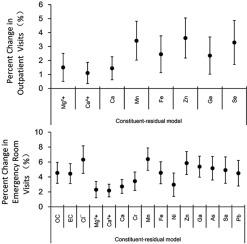Atmospheric Environment ( IF 5 ) Pub Date : 2021-07-06 , DOI: 10.1016/j.atmosenv.2021.118606 Dandan Yang 1, 2 , Cong Liu 1 , Li Peng 2 , Xiaofang Ye 2 , Ji Zhou 2 , Zhuocheng Mao 2 , Sixu Yang 2 , Haidong Kan 1 , Qingyan Fu 3 , Renjie Chen 1, 2

|
Background
Scarce evidence is available on the health effects of various chemical constituents of PM2.5 on hospital visits in China.
Objectives
To examine the short-term associations between a wide range of PM2.5 constituents and hospital outpatient and emergency room visits in Shanghai.
Methods
We obtained daily concentrations of PM2.5 total mass, organic carbon (OC), elemental carbon (EC), eight water-soluble ions and thirteen elemental constituents between January 1, 2014 and December 31, 2015. We analyzed the data using over dispersed generalized additive models with Poisson regression. Single-constituent, PM2.5-adjusted and constituent-residual models were built respectively to assess the associations. Exposure-response curves for the PM2.5 constituents with robust effects were graphed.
Results
The average daily mean PM2.5 concentration was 63.3 μg/m3 in Shanghai during the study period. An interquartile range (IQR) increase in PM2.5 was associated with a 2.57% (95% confidence interval [CI]: 1.28%, 3.87%) increase in outpatient visits, and a 3.60% (95% CI: 2.16%, 5.03%) increase in emergency room visits. We observed robust and positive associations between Mg2+, Ca2+, six elemental components (Ca, Mn, Fe, Zn, Ga and Se) and outpatient visits. OC, EC, Cl−, Mg2+, Ca2+ and ten elemental components (Ca, Cr, Mn, Fe, Zn, Ga, As, Se, Pb, and Ni) were significantly and positively associated with emergency room visits. The exposure-response relationships were positive and generally linear for the above constituents.
Conclusions
This time-series study in Shanghai demonstrated significant associations between various carbonaceous, water-soluble and elemental constituents of PM2.5 and hospital visits, providing evidence for source-specific control of particulate air pollution.


























 京公网安备 11010802027423号
京公网安备 11010802027423号